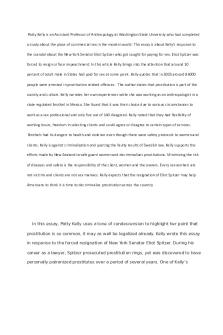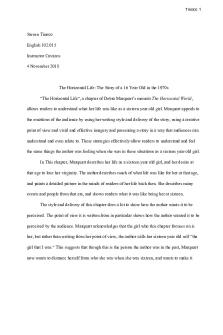Hidden Intellectualism Rhetorical Analysis PDF

| Title | Hidden Intellectualism Rhetorical Analysis |
|---|---|
| Author | Raziel Torres |
| Course | Writing In English Ii |
| Institution | Kean University |
| Pages | 4 |
| File Size | 47.8 KB |
| File Type | |
| Total Downloads | 72 |
| Total Views | 163 |
Summary
Download Hidden Intellectualism Rhetorical Analysis PDF
Description
Raziel Duvelsie Prof. L. Sisler
Eng. 1030
3, October 2020 “Rhetorical Analysis of Hidden Intellectualism” What is more important, being “street smart” or “book smart”? In the article “Hidden Intellectualism by Gerald Graff, he talks about how schools should tap into the street smarts of their students to enhance and improve their academic ability. Graff thinks the school system fails to notice the potential of street smarts and that schools are in the wrong for failing to support the “anti-intellectual” hobbies of their students. He argues that students will make more of an effort to do much better in school if they’re teachers encouraged them to study, work, and write about subjects that they were interested in. He talks about how he himself was more “street smart” than book smart growing up. He got more passionate and felt he became more of an intellectual when talking about subjects that he was genuinely interested in. Graff continues to mention how “anti-intellectual” subjects such as sports offers something that traditional “intellectual” school subjects fail to bring. That is a sense of community because while schools are more focused and push individual growth, a sports community promotes and stimulates growth as a collective. He strongly believes that schools should adopt these “anti-intellectual” topics and incorporate them into the curriculum because in his eyes a well thought out argument and detailed analysis of an article from something such as a magazine that the students enjoy would benefit the students way more than an ordinary routine response to a traditional academic piece. At the bottom of page 244 it states, “Gerald Graff, the co-author of this book, is a professor of English and education at the University of Illinois at Chicago. He is a past president of the Modern Language Association, the world’s largest professional association of university scholars and teachers.” Graff's argument focuses on the "intelligence" of students, so I believe his intended audience would be students
as well as parents and teachers because after reading this article they can become more open-minded and potentially learn to help students who do not yet notice their "hidden intellectualism." Graff also directs his argument at them so that they understand that there are many different areas in which someone can be “intellectual” and that is what makes every student different from the next. He is persuading the audience to consider the fact that being academically smart and getting good grades isn’t the only thing that defines a person as “smart”. He argues that students who are intelligent in areas besides school-related subjects still have the ability to use that knowledge as a way to learn education material. Graff’s thesis is found at the end of the first paragraph. It states, “What doesn’t occur to us, though, is that schools and colleges might be at fault for missing the opportunity to tap into such street smarts and channel them into academic work.”(p.244). In that paragraph he talks about how when someone who is smart when it regards day to day life topics yet doesn’t apply that intelligence to academic work, in society it is seen as a waste. He then points the attention to the schools and colleges because he believes it is their fault due to the fact that they fail to understand how they can use those “street smarts” to improve the work and academic interest of their students. By placing his thesis at the end on his first paragraph he triggers one to question why the schools at fault are and what can they do to improve. In the beginning of his article, Graff provides a personal anecdote. In doing so he provides ethos early so that the reader/audience trust him throughout the rest of the article. In the middle of his article, he uses a bit of logos to provide evidence for his main argument. Towards the end of his article, Graff includes pathos and includes it in the final paragraph to leave the audience emotionally attached. Though the vocabulary used in the article isn’t extremely complex, it still keeps a scholarly tone, using words such as “invidious”, “rudiments”, “cogitations”, and etc. Graff uses words such as “my” and
“we”, which help in unify him and the audience. By keeping a balance of a few difficult words in a relatively easy article he continues to appeal to those students who have more “street smarts” than “book smarts”. In order to strengthen the validity of his argument, Graff uses a number of facts from a variety of outside sources, including Sports Illustrated, Marilyn Monroe, Ted Williams (batting average), and Socrates. Aside from most of his logos references being well known figures, he also uses his own personal experience and how the intellectual world is like the sports world with theories, opposing texts, evaluation of texts, etc. An example of how he made this connection was when he stated, “It was in these discussions with friends about toughness and sports, I think, and in my reading of sports books and magazines, that I began to learn the rudiments of the intellectual life: how to make an argument, weigh different kinds of evidence, move between particulars and generalizations, summarize the views of others, and enter a conversation about ideas.”(247). As I mentioned earlier, on the first page of the article, there is a paragraph that gives some insight on who Gerald Graff is. It describes him as an educator and former president of the Modern Language Association. By including this information, the reader is able to trust Gerald Graff more because of his background. Graff also includes a personal anecdote that uses throughout the entire article. By providing a personal anecdote, he proves to the audience that he knows what he is talking about because he has experienced it, which establishes credibility. On page 247 he states, “it would be hard to imagine an adolescence more thoroughly anti-intellectual than mine.” Graff also includes a quote from a college professor named Ned Laff, which adds to his claim when says that the biggest difficulty facing students “is not simply to students' nonacademic interests, but to get them to see those interests through academic eyes." (250).
Graff uses pronouns such as “us” and “we” to connect with his audience and give the idea that he is apart of the group of “street-minded” students. He makes several bold claims showing that he sympathizes with these students such as when he exclaims, "Give me the student anytime who writes a sharply argued, sociologically acute analysis of an issue of "Source" over the student who writes a lifeless explication of "Hamlet" or Socrates' "Apology"(251). On page 247 he states, “Though I too thought I did not ‘dig the intellectual bit,’ I see now that I was unwittingly in training for it… I was practicing being an intellectual before I knew what I wanted to be”. By providing his own personal experience, his intended audience is appreciative of his dedications and passion because they can relate to him. In conclusion, I believe that we all are equally “book smart” and “street smart” in multiple areas. While some are fluent in one part, others are creative and knowledgeable in other parts. There are no boundaries when it comes to learning and everyone can learn something from someone else. A “streetsmart” student can add to a discussion that’s the equivalent of what a “book smart” student would likely bring to the table. Therefore, the board of education should allow teachers and professor to amend their lesson plans in other to make it more interesting and appealing to the students....
Similar Free PDFs

Hidden Intellectualism Framework
- 1 Pages

Rhetorical Analysis
- 5 Pages

Rhetorical analysis
- 2 Pages

Puppy Rhetorical Analysis
- 4 Pages

Rhetorical analysis -1
- 4 Pages

Bowling Dana Rhetorical Analysis
- 4 Pages

Rhetorical Analysis Essay
- 5 Pages

Textual Rhetorical Analysis
- 3 Pages

Rhetorical Analysis Final
- 5 Pages

Rhetorical Analysis Prompt
- 2 Pages
Popular Institutions
- Tinajero National High School - Annex
- Politeknik Caltex Riau
- Yokohama City University
- SGT University
- University of Al-Qadisiyah
- Divine Word College of Vigan
- Techniek College Rotterdam
- Universidade de Santiago
- Universiti Teknologi MARA Cawangan Johor Kampus Pasir Gudang
- Poltekkes Kemenkes Yogyakarta
- Baguio City National High School
- Colegio san marcos
- preparatoria uno
- Centro de Bachillerato Tecnológico Industrial y de Servicios No. 107
- Dalian Maritime University
- Quang Trung Secondary School
- Colegio Tecnológico en Informática
- Corporación Regional de Educación Superior
- Grupo CEDVA
- Dar Al Uloom University
- Centro de Estudios Preuniversitarios de la Universidad Nacional de Ingeniería
- 上智大学
- Aakash International School, Nuna Majara
- San Felipe Neri Catholic School
- Kang Chiao International School - New Taipei City
- Misamis Occidental National High School
- Institución Educativa Escuela Normal Juan Ladrilleros
- Kolehiyo ng Pantukan
- Batanes State College
- Instituto Continental
- Sekolah Menengah Kejuruan Kesehatan Kaltara (Tarakan)
- Colegio de La Inmaculada Concepcion - Cebu





